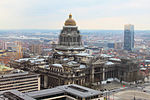Belgian Infantry Memorial, Brussels
City of BrusselsMonuments and memorials in BelgiumTourist attractions in BrusselsWorld War I memorials in Belgium

The Belgian Infantry Memorial (French: Monument à l'Infanterie Belge, Dutch: Monument voor de Belgische infanterie) is a monument in Brussels, Belgium, which stands in memory of the Belgian foot soldiers who fought in World War I and World War II. Designed by Edouard Vereycken, the memorial stands in front of Brussels' Palace of Justice and across the Place Poelaert/Poelaertplein from the Anglo-Belgian War Memorial. The memorial rests on a raised platform that overlooks Brussels' city centre. Translated into English, the inscription reads: "To the infantrymen who died for their country".
Excerpt from the Wikipedia article Belgian Infantry Memorial, Brussels (License: CC BY-SA 3.0, Authors, Images).Belgian Infantry Memorial, Brussels
Place Poelaert - Poelaertplein, City of Brussels Pentagon (Brussels)
Geographical coordinates (GPS) Address External links Nearby Places Show on map
Geographical coordinates (GPS)
| Latitude | Longitude |
|---|---|
| N 50.837795 ° | E 4.352506 ° |
Address
Monument à la Gloire de l'Infanterie Belge - Monument ter ere van de Belgische Infanterie
Place Poelaert - Poelaertplein
1000 City of Brussels, Pentagon (Brussels)
Belgium
Open on Google Maps









